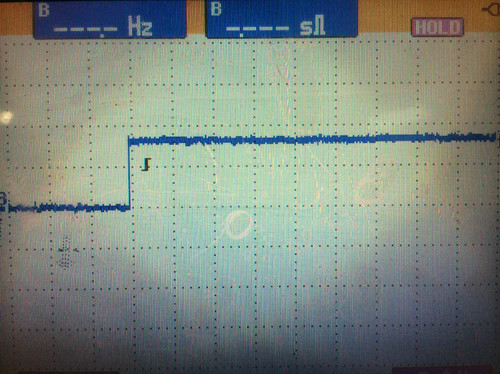/****************************************************************
Function: OCActive_GPIO_Init
Description: Output compare active mode timer channel pin configuration
Input: none
return: none
**************************************************************/
static void OCActive_GPIO_Init(void)
{
GPIO_InitTypeDef GPIO_InitStructure;
RCC_APB2PeriphClockCmd(RCC_APB2Periph_GPIOA, ENABLE);
GPIO_InitStructure.GPIO_Pin = GPIO_Pin_0 | GPIO_Pin_1 | GPIO_Pin_2 | GPIO_Pin_3;
GPIO_InitStructure.GPIO_Mode = GPIO_Mode_AF_PP; //Timer channel pins are configured as multiplexed push-pull output
GPIO_InitStructure.GPIO_Speed = GPIO_Speed_50MHz;
GPIO_Init(GPIOA, &GPIO_InitStructure);
}
u16 CCR1_Val = 10000;
u16 CCR2_Val = 5000;
u16 CCR3_Val = 2500;
u16 CCR4_Val = 1250;
/****************************************************************
Function: OCActive_TIM2_Init
Description: Timer 2 is configured to output compare active mode
Input: none
return: none
**************************************************************/
static void OCActive_TIM2_Init(void)
{
TIM_TimeBaseInitTypeDef TIM_TimeBaseStructure;
TIM_OCInitTypeDef TIM_OCInitStructure;
RCC_APB1PeriphClockCmd(RCC_APB1Periph_TIM2, ENABLE); //Initialize TIM2 clock
/* -------------------------------------------------------
The timer's beat is 720000000/36000/2=1kHz,
TIM_OCMode_Active mode forces the output to be high, and
each channel pin is originally at a low level. After the following delay, it jumps to a high level
TIM2_CH1 delay = CCR1_Val/1kHz = 10s
TIM2_CH2 delay = CCR2_Val/1kHz = 5s
TIM2_CH3 delay = CCR3_Val/1kHz = 2.5s
TIM2_CH4 delay = CCR4_Val/1kHz = 1.25s
---------------------------------------------------------*/
TIM_TimeBaseStructure.TIM_Period = 60000; //Timer counting period
TIM_TimeBaseStructure.TIM_Prescaler = 36000 - 1; //Prescaler
TIM_TimeBaseStructure.TIM_ClockDivision = 2 - 1; //Clock 2 division
TIM_TimeBaseStructure.TIM_CounterMode = TIM_CounterMode_Up; //Increase count
TIM_TimeBaseInit(TIM2, &TIM_TimeBaseStructure); //Initialize timer
TIM_OCInitStructure.TIM_OCMode = TIM_OCMode_Active;//Output comparison active modeTIM_OCInitStructure.TIM_OutputState
= TIM_OutputState_Enable;//Output enableTIM_OCInitStructure.TIM_Pulse
= CCR1_Val;//Set comparison value (jump value)
TIM_OCInitStructure.TIM_OCPolarity = TIM_OCPolarity_High;//The effective level is high
levelTIM_OC1Init(TIM2, &TIM_OCInitStructure);//Initialize output compare registerTIM_OC1PreloadConfig
(TIM2, TIM_OCPreload_Disable);//Turn off preloadTIM_OCInitStructure.TIM_OutputState
= TIM_OutputState_Enable;//Output enableTIM_OCInitStructure.TIM_Pulse
= CCR2_Val;//Set comparison value (jump value)
TIM_OC2Init(TIM2, &TIM_OCInitStructure);//Initialize output compare register
TIM_OC2PreloadConfig(TIM2, TIM_OCPreload_Disable);
TIM_OCInitStructure.TIM_OutputState = TIM_OutputState_Enable;//Output enable
TIM_OCInitStructure.TIM_Pulse = CCR3_Val;//Set comparison value (jump value)
TIM_OC3Init(TIM2, &TIM_OCInitStructure);//Initialize output compare register
TIM_OC3PreloadConfig(TIM2, TIM_OCPreload_Disable);
TIM_OCInitStructure.TIM_OutputState = TIM_OutputState_Enable;//Output enable
TIM_OCInitStructure.TIM_Pulse = CCR4_Val;//Set comparison value (jump value)
TIM_OC4Init(TIM2, &TIM_OCInitStructure); //Initialize output compare register
TIM_OC4PreloadConfig(TIM2, TIM_OCPreload_Disable);
TIM_ARRPreloadConfig(TIM2, ENABLE); //Turn on the automatic reload function of timer 2
TIM_Cmd(TIM2, ENABLE); //Turn on timer 2
}
/****************************************************************
Function: OCActive_Init
Description: Output compare active M mode initialization
Input: none
return: none
*************************************************************/
void OCActive_Init(void)
{
OCActive_GPIO_Init();
OCActive_TIM2_Init();
}
#ifndef __OCACTIVE_H__
#define __OCACTIVE_H__
#include "stm32f10x.h"
void OCActive_Init(void);
#endif
/****************************************************** ************
Function: main
Description: mainInput
: none
return: none
************************* **********************************/
int main(void)
{
BSP_Init();
OCActive_Init() ;
PRINTF("\nmain() is running!\r\n");
while(1)
{
LED1_Toggle();
Delay_ms(1000);
}
}

Previous article:STM32 timer output compare non-active mode
Next article:STM32 timer output comparison time mode
- Popular Resources
- Popular amplifiers
- Learn ARM development(16)
- Learn ARM development(17)
- Learn ARM development(18)
- Embedded system debugging simulation tool
- A small question that has been bothering me recently has finally been solved~~
- Learn ARM development (1)
- Learn ARM development (2)
- Learn ARM development (4)
- Learn ARM development (6)
 Professor at Beihang University, dedicated to promoting microcontrollers and embedded systems for over 20 years.
Professor at Beihang University, dedicated to promoting microcontrollers and embedded systems for over 20 years.
- LED chemical incompatibility test to see which chemicals LEDs can be used with
- Application of ARM9 hardware coprocessor on WinCE embedded motherboard
- What are the key points for selecting rotor flowmeter?
- LM317 high power charger circuit
- A brief analysis of Embest's application and development of embedded medical devices
- Single-phase RC protection circuit
- stm32 PVD programmable voltage monitor
- Introduction and measurement of edge trigger and level trigger of 51 single chip microcomputer
- Improved design of Linux system software shell protection technology
- What to do if the ABB robot protection device stops
- Wiring harness durability test and contact voltage drop test method
- From probes to power supplies, Tektronix is leading the way in comprehensive innovation in power electronics testing
- From probes to power supplies, Tektronix is leading the way in comprehensive innovation in power electronics testing
- Sn-doped CuO nanostructure-based ethanol gas sensor for real-time drunk driving detection in vehicles
- Design considerations for automotive battery wiring harness
- Do you know all the various motors commonly used in automotive electronics?
- What are the functions of the Internet of Vehicles? What are the uses and benefits of the Internet of Vehicles?
- Power Inverter - A critical safety system for electric vehicles
- Analysis of the information security mechanism of AUTOSAR, the automotive embedded software framework
- Brief Analysis of Automotive Ethernet Test Content and Test Methods
- [Help] spx3819-3.3 regulated output
- Is it a voltage comparator or an oscillator circuit?
- Problems with the full-bridge circuit formed by dual MOS tube Si4288
- Radio frequency allocation map
- [National Technology N32 MCU Development Data]--Full Series Product Selection Table
- CH340G cannot download
- Super detailed! Help you understand the internal structure of the switching power supply chip
- Use VSCode to compile and debug BlueNRG-1 code
- 【AT32WB415 Review】05 RTC Test + Adding Electronic Clock Interface
- Summary of bare metal program burning method for embedded Linux development board

 LM208HB
LM208HB
















 京公网安备 11010802033920号
京公网安备 11010802033920号